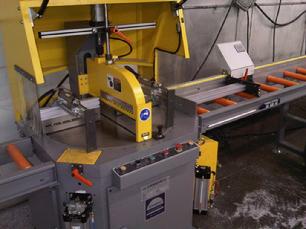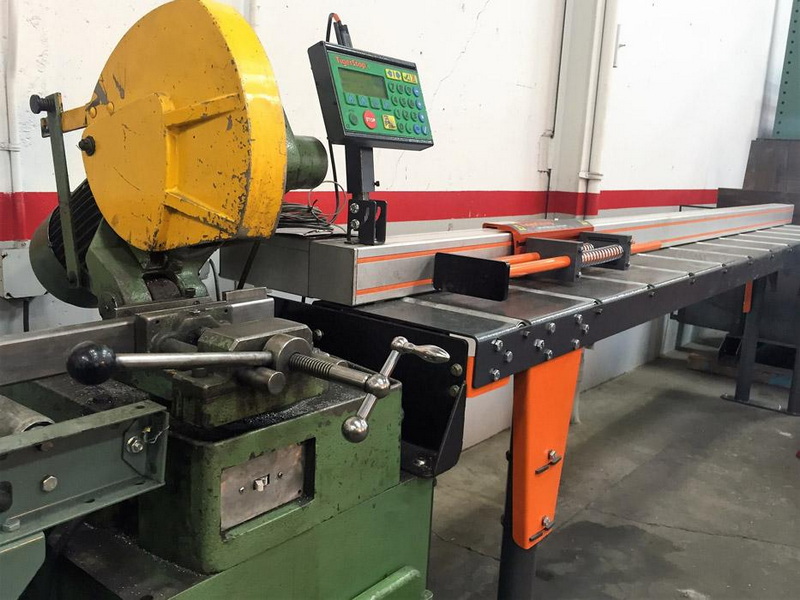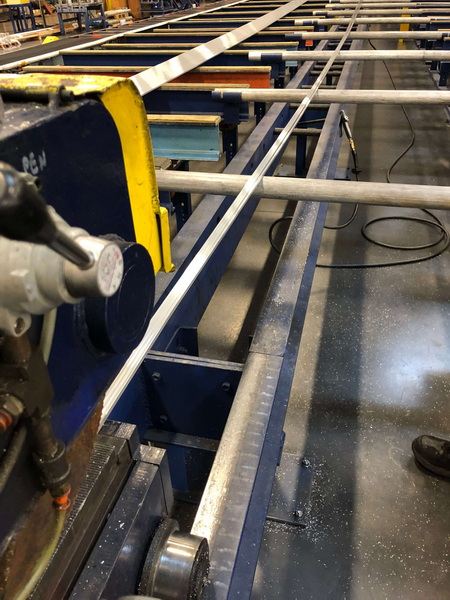Content Menu
● Understanding Aluminum Extrusions
● The Importance of Precision Cuts
● Tools for Cutting Aluminum Extrusions
>> Miter Saw
>> Band Saw
>> Table Saw
>> Circular Saw
● Techniques for Achieving Precision Cuts
>> Measure Twice, Cut Once
>> Secure the Workpiece
>> Use a Guide
>> Take Your Time
>> Use Proper Cutting Speed
● Safety Precautions
● Maintenance of Cutting Tools
● Advanced Techniques for Precision Cutting
>> CNC Machining
>> Laser Cutting
>> Water Jet Cutting
● Common Mistakes to Avoid
>> Not Using the Right Blade
>> Rushing the Process
>> Failing to Secure the Workpiece
>> Ignoring Safety Precautions
● Conclusion
● Frequently Asked Questions
>> 1. What type of blade should I use for cutting aluminum extrusions?
>> 2. Can I use a regular saw to cut aluminum?
>> 3. How do I prevent aluminum from binding during cutting?
>> 4. What safety gear should I wear when cutting aluminum?
>> 5. How can I ensure my cuts are straight?
Understanding Aluminum Extrusions
Aluminum extrusion is a process that involves shaping aluminum alloy by forcing it through a die. This results in long lengths of aluminum with a consistent cross-sectional profile. The versatility of aluminum extrusions allows them to be used in various applications, including frames, supports, and enclosures. However, to utilize these extrusions effectively, precise cutting is crucial.
Aluminum is favored in many industries due to its lightweight nature, resistance to corrosion, and excellent strength-to-weight ratio. These properties make it an ideal choice for applications ranging from construction to automotive manufacturing. However, the effectiveness of aluminum extrusions is heavily dependent on how accurately they are cut.

The Importance of Precision Cuts
Precision cuts ensure that the aluminum extrusions fit together correctly, which is vital for structural integrity and aesthetic appeal. Inaccurate cuts can lead to gaps, misalignments, and wasted materials. Therefore, understanding how to achieve precision cuts is essential for anyone working with aluminum extrusions.
When working on projects that require aluminum extrusions, the quality of the cut can significantly impact the overall outcome. For instance, in construction, poorly cut aluminum can lead to structural weaknesses, while in design applications, it can affect the visual appeal of the final product.
Tools for Cutting Aluminum Extrusions
To achieve precision cuts, you need the right tools. Here are some commonly used tools for cutting aluminum extrusions:
Miter Saw
A miter saw is one of the most popular tools for cutting aluminum extrusions. It allows for angled cuts and is ideal for making crosscuts. When using a miter saw, it is essential to equip it with a blade specifically designed for cutting aluminum. These blades have fewer teeth and are made from materials that can handle the softness of aluminum without causing excessive wear.
Band Saw
A band saw is another excellent option for cutting aluminum extrusions. It provides a smooth cut and is suitable for both straight and curved cuts. When using a band saw, ensure that the blade is appropriate for aluminum to prevent binding and ensure a clean cut.
Table Saw
A table saw can also be used for cutting aluminum extrusions, especially for long pieces. It is essential to use a non-ferrous blade designed for cutting aluminum. Additionally, using a fence can help guide the extrusion for a straight cut.
Circular Saw
A circular saw is a versatile tool that can be used for cutting aluminum extrusions. When using a circular saw, it is crucial to use a blade designed for non-ferrous metals. This will help achieve a clean cut and reduce the risk of the blade binding.
Techniques for Achieving Precision Cuts
Now that we have discussed the tools, let's explore some techniques to achieve precision cuts in aluminum extrusions.
Measure Twice, Cut Once
Before making any cuts, it is essential to measure the length of the aluminum extrusion accurately. Use a tape measure and mark the cut line with a pencil or marker. Double-check your measurements to ensure accuracy. This old adage, "measure twice, cut once," is particularly important when working with aluminum extrusions.
Secure the Workpiece
To achieve a clean and precise cut, it is crucial to secure the aluminum extrusion properly. Use clamps to hold the extrusion in place on your work surface. This will prevent movement during cutting, which can lead to inaccuracies.
Use a Guide
When cutting long pieces of aluminum, using a guide can help ensure a straight cut. You can use a straight edge or a cutting guide to align your saw with the marked cut line. This technique is especially useful when using a circular saw or a table saw.
Take Your Time
Rushing through the cutting process can lead to mistakes. Take your time and allow the saw to do the work. Forcing the saw through the material can cause binding and result in an uneven cut.
Use Proper Cutting Speed
Different tools have different optimal cutting speeds. For instance, a miter saw should be operated at a moderate speed to prevent overheating the blade. If you notice the blade getting hot, pause and allow it to cool down before continuing.
Safety Precautions
When cutting aluminum extrusions, safety should always be a priority. Here are some safety tips to keep in mind:
- Wear Safety Gear: Always wear safety glasses to protect your eyes from metal shavings and debris. Hearing protection is also recommended, especially when using loud power tools.
- Keep Your Workspace Clean: A clean workspace reduces the risk of accidents. Remove any clutter and ensure that your tools are organized.
- Check Your Tools: Before starting, inspect your tools to ensure they are in good working condition. Replace any dull blades, as they can lead to poor cuts and increase the risk of accidents.

Maintenance of Cutting Tools
To achieve consistent precision cuts, it is essential to maintain your cutting tools. Here are some maintenance tips:
- Clean the Blades: After each use, clean the blades to remove any aluminum residue. This will help maintain their cutting efficiency.
- Sharpen Blades Regularly: Dull blades can lead to inaccurate cuts and increased wear on the tool. Regularly sharpen or replace blades as needed.
- Store Tools Properly: Store your tools in a dry, clean environment to prevent rust and damage.
Advanced Techniques for Precision Cutting
For those looking to take their cutting skills to the next level, consider these advanced techniques:
CNC Machining
CNC (Computer Numerical Control) machining is a highly precise method for cutting aluminum extrusions. This technology allows for automated cutting based on programmed specifications, ensuring that every cut is exact. CNC machines can handle complex shapes and designs, making them ideal for intricate projects.
Laser Cutting
Laser cutting is another advanced technique that offers exceptional precision. This method uses a high-powered laser to cut through aluminum with minimal material loss. Laser cutting is particularly useful for detailed designs and can produce clean edges without the need for additional finishing.
Water Jet Cutting
Water jet cutting utilizes a high-pressure stream of water mixed with abrasive materials to cut through aluminum. This method is effective for thick extrusions and can achieve intricate designs without generating heat, which can affect the material properties.
Common Mistakes to Avoid
When cutting aluminum extrusions, there are several common mistakes that can lead to poor results. Here are some to watch out for:
Not Using the Right Blade
Using the wrong blade can lead to rough cuts and damage to the material. Always ensure that you are using a blade designed for cutting aluminum.
Rushing the Process
Cutting too quickly can result in inaccuracies and poor-quality cuts. Take your time and allow the tool to do the work.
Failing to Secure the Workpiece
Not securing the aluminum extrusion can lead to movement during cutting, resulting in uneven cuts. Always use clamps or a vise to hold the workpiece in place.
Ignoring Safety Precautions
Neglecting safety measures can lead to accidents and injuries. Always wear appropriate safety gear and keep your workspace organized.
Conclusion
Achieving precision cuts in aluminum extrusions is a skill that can significantly enhance the quality of your projects. By using the right tools, techniques, and safety precautions, you can ensure that your cuts are accurate and clean. Whether you are a professional in the industry or a DIY enthusiast, mastering the art of cutting aluminum extrusions will open up a world of possibilities for your projects.

Frequently Asked Questions
1. What type of blade should I use for cutting aluminum extrusions?
Use a blade specifically designed for non-ferrous metals, which typically has fewer teeth and is made from materials that can handle aluminum.
2. Can I use a regular saw to cut aluminum?
While you can use a regular saw, it is recommended to use a saw with a blade designed for aluminum to achieve better results and prevent damage to the blade.
3. How do I prevent aluminum from binding during cutting?
Ensure that you are using the correct blade and cutting speed. Additionally, securing the workpiece and taking your time can help prevent binding.
4. What safety gear should I wear when cutting aluminum?
Always wear safety glasses to protect your eyes and consider using hearing protection when operating loud power tools.
5. How can I ensure my cuts are straight?
Use a guide or straight edge to align your saw with the marked cut line, and secure the workpiece to prevent movement during cutting.
This comprehensive guide provides valuable insights into achieving precision cuts in aluminum extrusions, covering tools, techniques, safety measures, and advanced methods. By following these guidelines, you can enhance your cutting skills and ensure high-quality results in your projects.






















